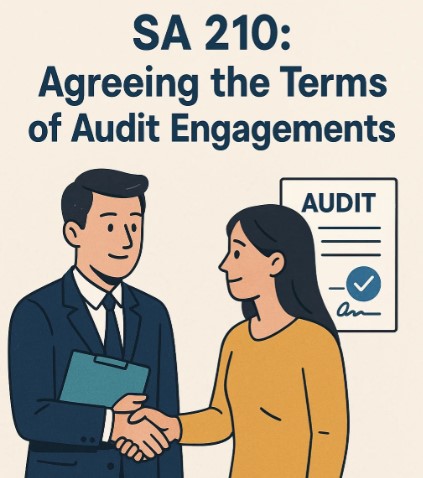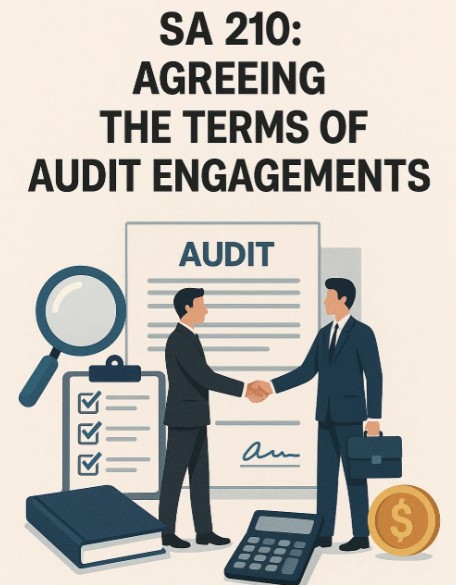
SA 210: Agreeing the Terms of Audit Engagements
The goal of this standard is not only to prevent disputes and misunderstandings but also to promote transparency, maintain a high level of professional ethics, and ensure the overall integrity of the audit process. This blog delves into the key aspects of SA 210, its significance, and how it fosters a professional and transparent relationship between the auditor and the client.
A well-defined audit engagement letter is the foundation of a smooth audit process. It ensures transparency, sets clear expectations, and minimizes the risk of disputes. With SA 210, both the auditor and the client are aligned from the start, fostering a professional and efficient relationship.
What is SA 210?
SA 210, issued by the Institute of Chartered Accountants of India (ICAI), outlines the auditor’s responsibility to establish and document the terms of the audit engagement with the client before the commencement of any audit work. The standard’s main objective is to ensure that both the auditor and the client share a mutual understanding of the scope and objectives of the audit, as well as the responsibilities and obligations that each party is expected to fulfill.
The terms of engagement are typically captured in a formal audit engagement letter, which serves as the foundation for the relationship between the auditor and the client. This letter provides a clear outline of what the auditor will do, the timeline for completing the audit, and the professional and ethical guidelines that will govern the engagement.
In the absence of an agreed-upon engagement letter, misunderstandings can arise about the auditor's duties, the client’s expectations, or the overall scope of the work to be performed. This can ultimately lead to disputes, delays, or even legal ramifications, which can harm the reputation of both parties. SA 210 therefore ensures that both parties are on the same page before the engagement begins, fostering a smoother, more efficient audit process.
Key Provisions of SA 210
The provisions of SA 210 provide a structured approach to agreeing on the terms of an audit engagement, ensuring that both the auditor and the client are aware of their roles and expectations. Some of the most important provisions include:
- Establishing Clear Terms: The primary objective of SA 210 is to ensure that there is a clear, written agreement between the auditor and the client. This agreement, typically in the form of an audit engagement letter, formalizes the scope of the audit, the auditor’s responsibilities, and the client’s obligations. This document should be prepared before the start of the audit and must be signed by both parties to indicate their consent.
- Audit Engagement Letter Content: The audit engagement letter should contain the following critical components:
- Scope of the Audit: This section outlines the specific areas the audit will cover, including the financial statements, accounting records, and other related documents. It also clarifies what is excluded from the audit.
- Auditor’s Responsibilities: This defines the role of the auditor, which generally includes the responsibility to conduct the audit in accordance with relevant auditing standards and to express an opinion on the financial statements.
- Management’s Responsibilities: The letter also specifies that management is responsible for the preparation of the financial statements, maintaining an adequate system of internal controls, and providing the auditor with access to all necessary information.
- Basis of Remuneration: The letter outlines the terms for compensation for the audit services provided. This may include fixed fees, hourly rates, or payment based on milestones.
- Other Specifics: This includes any specific arrangements that may apply to the engagement, such as deadlines, delivery of audit reports, or the provision of special reports.
- Understanding the Client’s Business Environment: A crucial part of agreeing the terms of the audit is the auditor’s need to understand the client’s business and the industry in which it operates. The nature of the client’s business often affects the scope and complexity of the audit, including the risks involved. For example, a company operating in a highly regulated sector may require a more detailed audit to ensure compliance with industry-specific rules and regulations.
- Consideration of Relevant Laws and Regulations: Compliance with legal and regulatory frameworks is a critical aspect of any audit engagement. SA 210 stresses the importance of ensuring that the terms of the audit engagement are consistent with all relevant laws, including financial reporting regulations, tax laws, and corporate governance standards. In certain jurisdictions, there may be statutory requirements that mandate the auditor’s role, scope of work, or reporting obligations.
- Client Consent: After the auditor drafts the engagement letter and ensures all terms are clearly defined, it is essential for the client to formally agree to the terms. This step often involves a signature from a representative of the client, confirming that they understand and agree with the outlined scope, responsibilities, and remuneration terms.

Why is SA 210 Important?
The importance of SA 210 cannot be overstated, as it serves as the foundation for the entire audit process. By defining clear terms and expectations, it contributes to a smooth and efficient audit process. Here are several reasons why SA 210 is critical for auditors and clients alike:
- Prevents Disputes: By defining the audit’s scope, responsibilities, and expectations in writing, SA 210 significantly reduces the potential for misunderstandings or disputes during the audit. Both parties have a clear understanding of what is expected, what will be covered, and the timelines for completion, which minimizes confusion and ensures that the audit is conducted in a professional manner.
- Maintains Professional Standards: The engagement letter is also an important tool in ensuring that auditors adhere to ethical and professional standards. SA 210 requires auditors to communicate effectively with their clients and establish a transparent, professional relationship. The auditor is expected to act with integrity and independence, and the engagement letter ensures that these expectations are clearly communicated.
- Defines Audit Boundaries: A major benefit of SA 210 is that it helps define the boundaries of the audit. The engagement letter clearly specifies the scope of the audit and the auditor’s responsibilities, making it clear what areas are included and which ones are excluded. This is particularly important in complex or large organizations where the audit might cover a wide range of activities, operations, and financial statements.
- Strengthens the Client-Auditor Relationship: A well-written engagement letter establishes a positive, professional relationship between the auditor and the client. It encourages open communication and sets a tone of mutual respect, as both parties have an opportunity to discuss and agree on the terms of the engagement before it begins.
Audit Engagement Letter Best Practices
To ensure that the engagement letter is effective and legally binding, auditors should follow best practices when drafting the letter. Some of these include:
- Use Clear and Simple Language: Avoid jargon or overly complex legal terms. The language should be straightforward and easy to understand for both parties.
- Comprehensive Coverage: Ensure the letter addresses all aspects of the audit, including scope, responsibilities, timelines, and remuneration. This will reduce the likelihood of confusion or disputes later.
- Confirm Client Understanding: The auditor should review the engagement letter with the client and ensure they fully understand the terms before proceeding.
- Regular Review: The terms of the engagement should be reviewed periodically, especially if there are any significant changes to the client’s business or operations.
- Document Amendments: If the terms of the engagement change during the audit, the auditor should document these changes and obtain the client’s consent before proceeding.
Conclusion
SA 210 - Agreeing the Terms of Audit Engagements is a fundamental standard in the auditing profession. It serves as a crucial mechanism for ensuring transparency, clarity, and mutual understanding between the auditor and the client. By setting clear expectations and outlining the roles and responsibilities of both parties, the engagement letter ensures that the audit process proceeds smoothly, reduces the risk of disputes, and promotes a professional relationship.
Ultimately, SA 210 helps auditors and clients achieve their goals efficiently, ensures that audits are conducted in compliance with regulatory standards, and maintains the integrity of the audit process. The standard is an essential tool for auditors, fostering a foundation of professionalism, trust, and clarity.
Are you clear on the terms that govern your audit engagement?
